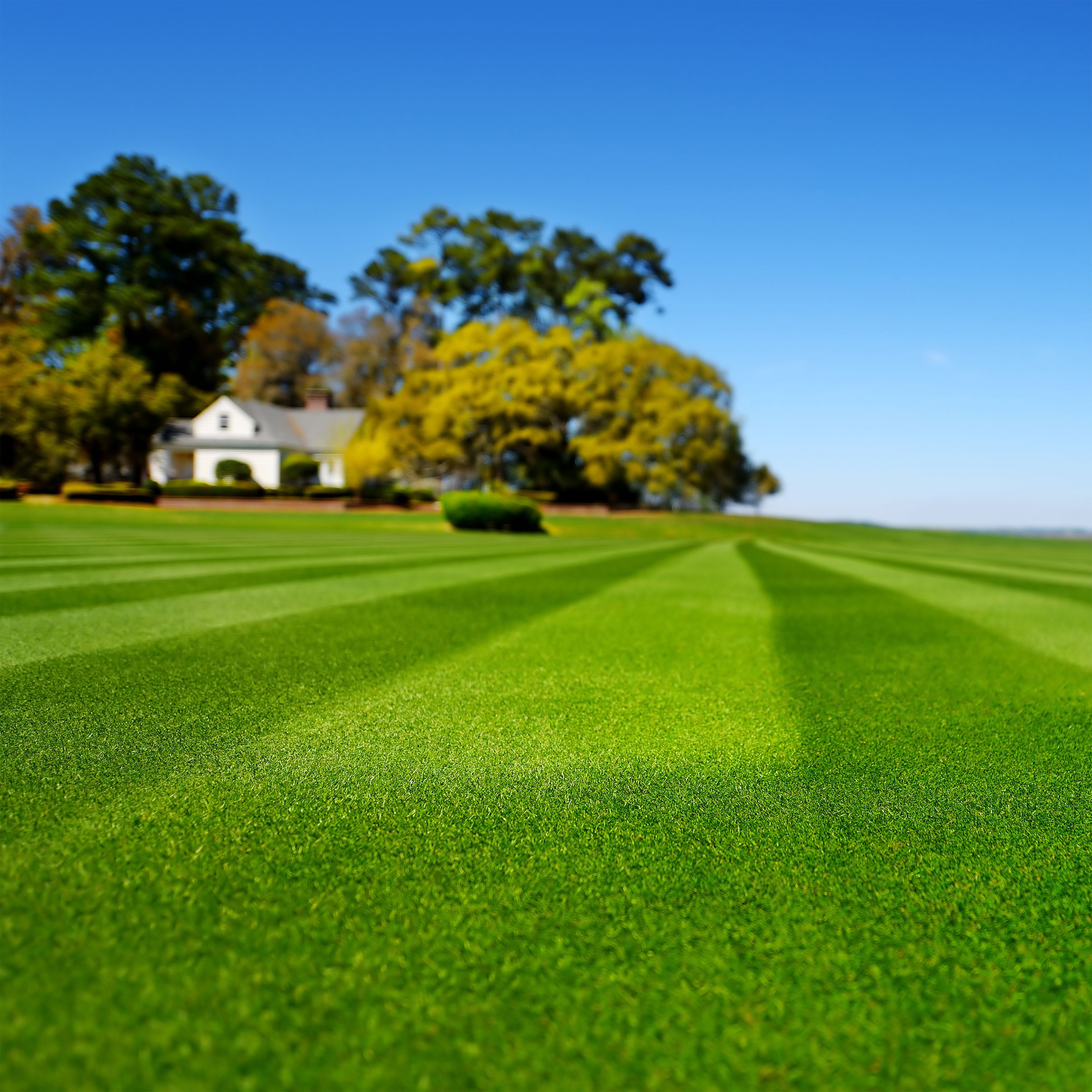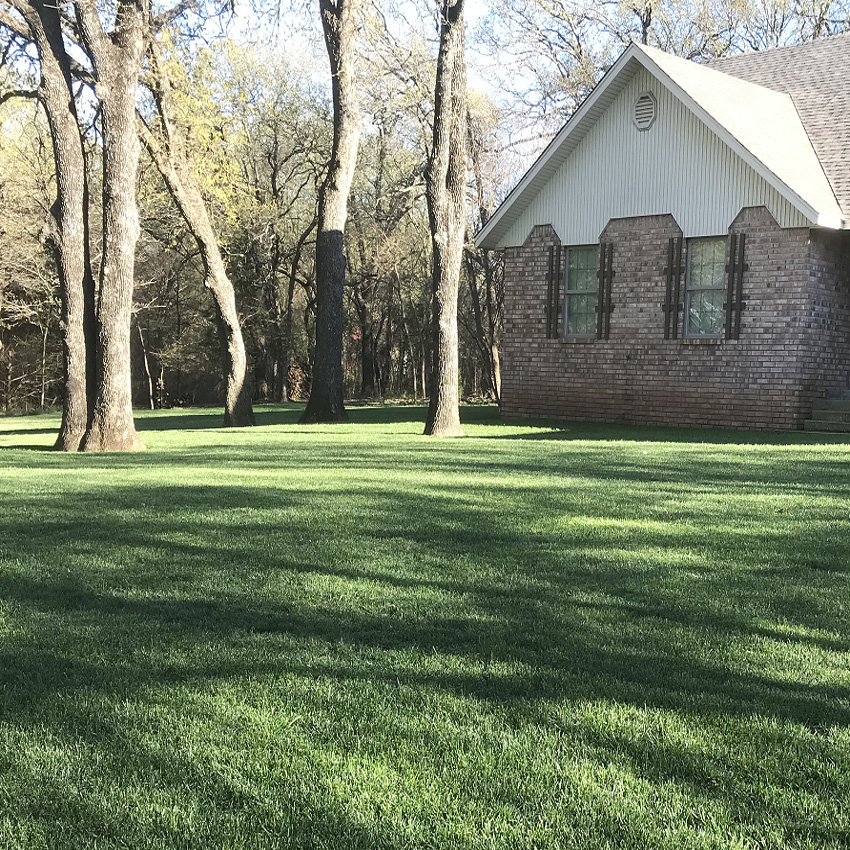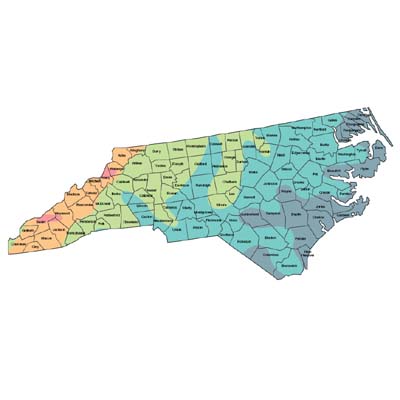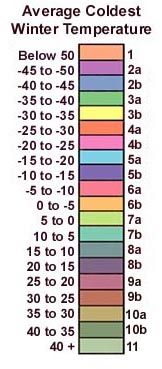
Blackjack Bermudagrass
- Cost Effective
- Warm Season
- Deep green color
Grasses used in North Carolina generally consists of warm season grasses such as: bermuda, zoysia, centipede, and carpet grass is even used in shady, wet areas of the state. Warm-season grasses are green in the summer and become brown and dormant in the winter. Warm-season grasses are adapted to the sandy soils of the North Carolina coastal plain and most of the piedmont. Warm-season grasses tolerate the high temperatures and summer droughts in North Carolina better than cool-season grasses. Cool season grasses such as turf type tall fescue can also be used in areas where year round green turf is desired. Ryegrass is typically just used for overseeding warm season grasses in North Carolina.
Bermuda Grass - Bermudagrass is the species most adapted to and most frequently used throughtout the state. Many new and improved seeded varieties have been developed and released during the last 10 years. Users now have a choice of varieties that are denser and finer textured than the almost extinct seed of common bermudagrass. Bermudagrass spreads aggressively by stolons (aboveground runners) and rhizomes (belowground runners) and can become a nuisance when it invades flower beds and gardens. Also, cold-tolerant seeded and vegetative varieties are available that withstand lower winter temperatures.
Centipede Grass - Medium in texture with a pale to medium green color, Centipede is slow growing but highly aggressive grass that can be depended upon to produce a good, dense, relatively weed-free turf at low maintenance levels. In spite of its aggressiveness, Centipede is easily controlled and usually requires edging only once a year around walks and flowerbeds. Although Centipede usually produces a good turf at low fertility and with little management, it responds nicely to good care.
Cool-Season Grasses:
Tall fescue - Turf Type - Tall fescue is a persistent and durable plant that forms acceptable turf for home lawns, grounds, parks, playgrounds, and athletic fields. It is commonly used in low maintenance situations such as utility areas, highway medials, airstrips, and fairgrounds. Many new and improved varieties have finer texture, higher tiller densities, and a darker-green color than the coarse-textured, light-green varieties such as 'Kentucky 31' and 'Alta.' Tall fescue is considered by many individuals to be incompatible with the finer-textured and darker-green Kentucky bluegrass, perennial ryegrass, and fine fescues. Tall fescue may be objectionable in a mixture with fine-textured turfgrass species because it tends to form coarse-textured clumps in an otherwise uniform stand.
Tall fescue is primarily a bunch-type grass that occasionally produces short rhizomes. It is somewhat slow to establish extensive root systems and has only fair recovery potential. This species is the most heat and drought tolerant of the cool-season turfgrasses. The increased drought tolerance is a function of its ability to produce a deep root system. Tall fescue performs well in open, sunny areas and is moderately shade tolerant. It is less suited to heavily-shaded conditions than the fine fescues, but is more shade tolerant than Kentucky bluegrass and perennial ryegrass. Tall fescue is best suited to well-drained soils.
Kentucky bluegrass - Kentucky bluegrass is a persistent and attractive species that is used in many home lawns, institutional grounds, parks, and athletic fields. This species has a medium to fine leaf texture and a medium- to dark-green color when properly fertilized. It produces extensive underground stems, called rhizomes, which provide good sod-forming characteristics and superior recuperative potential when compared to most other cool-season turfgrasses. Kentucky bluegrass is cold tolerant, wear tolerant, and moderately heat and drought tolerant. It makes optimum growth during the spring and fall and becomes semi-dormant under prolonged periods of heat and drought. It usually recovers quickly from dormancy with the advent of cooler temperatures and adequate soil moisture.
Perennial ryegrass - Ryegrass is a persistent, dark-green, fine to medium-textured turfgrass that is used for home lawns, parks, grounds, golf courses, and athletic fields. This species produces a bunch-type growth habit and does not form rhizomes or stolons. Its recuperative potential is not as strong as Kentucky bluegrass. Perennial ryegrass germinates rapidly (5 to 7 days) and establishes quickly. It is very competitive with other turfgrasses and is used extensively for overseeding thin or damaged turf. Because of its aggressive nature, perennial ryegrass is generally not used in amounts over 20 percent in a mixture with other turfgrasses. It is suitable for use alone or in combination with Kentucky bluegrass and/or fine fescues.
Perennial ryegrasses is wear tolerant and heat tolerant. It is only moderately tolerant of shade and drought. This species will withstand low temperatures, however, it tends to be susceptible to ice damage. Perennial ryegrass performs best on moderate to high-fertility soils and well-drained soils. Ryegrass is typically only used to overseed bermuda grass with in North Carolina.
| Click Name To View Grass Seed Choice | Type | Applications | |
|---|---|---|---|
| Bermuda Grass - Oasis |
|
Warm Season | Lawns - Full Sun - Fast Growing |
| Bermuda Grass - Blackjack |
|
Warm Season | Lawns - Full Sun - Fast Growing |
| Bermuda Grass - Yukon |
|
Warm Season |
Lawns - Golf Course - Fast Growing Full Sun - High End - Best Cold Tolerance |
| Bermuda Grass - Arden 15 |
|
Warm Season |
Lawns - Golf Course - Fast Growing Full Sun - High End |
| Centipede Grass |
|
Warm Season | Lawns - Mostly Sunny to Full Sun - Low Maintenance |
| Cool Season Mix - Showtime |
|
Cool Season |
Lawns - Moderate Shade Rye, Kentucky Bluegrass, Fine Fescue Mix |
| Cool Season Mix - Garland |
|
Cool Season |
Lawns - Moderate Shade Rye, Fine Fescue Mix |
| Fescue/Bluegrass Mix - Combat Extreme South |
|
Cool Season | Lawns - Wear Tolerant - Extra Heat Tolerance |
| Fescue Blend - Combat Extreme Transition |
|
Cool Season | Lawns - Wear Tolerant |
| Fine Fescue Blend - Legacy |
|
Cool Season | Lawns - Moderate to Dense Shade |
| Kentucky Bluegrass - Bluegrass Supreme |
|
Cool Season | Lawns - Golf Gourses - Full Sun |
| Kentucky Bluegrass - Midnight |
|
Cool Season | Lawns - Golf Courses - Full Sun |
| OSP Ryegrass |
|
Cool Season | Lawns - Golf Courses |


Below is the USDA Zone Map for North Carolina so you can determine which zone you reside in. Below that are our picks for your state which will do best in your area. Next on this page are tables which list various grasses and their characteristics so you can compare before you decide on your purchase. Click on the product name (ie. Midnight) for more information about that grass and to make your purchase.
| USDA Zone Map For North Carolina | |
|---|---|
 |
 |
| Compare Various Grasses For Their Characteristics | ||||||||
|---|---|---|---|---|---|---|---|---|
| Cool Season Grasses |
Leaf Texture |
Establish Rate |
Nitrogen Use |
Water Use |
Drought Tolerance |
Salinity Tolerance |
Shade Tolerance |
|
| Fescue - Hard | Fine | Slow to Moderate |
Low to Very Low |
Moderate | Excellent | Low to Moderate |
Excellent | |
| Fescue - Creeping | Fine | Moderate | Low to Moderate |
Moderate | Good | Low | Excellent | |
| Fescue - Turf Type | Moderate to Coarse |
Moderate | Moderate to High |
Low to Moderate |
Excellent | Low | Good to Excellent |
|
| Ryegrass - Perennial | Fine to Moderate |
Very Fast | Moderate to High |
Moderate to High |
Good | Poor to Moderate |
Poor to Moderate |
|
| Warm Season Grasses |
Leaf Texture |
Establish Rate |
Nitrogen Use |
Water Use |
Drought Tolerance |
Salinity Tolerance |
Shade Tolerance |
|
| Bermudagrass | Fine to Moderate |
Moderate to Fast |
Moderate | Moderate to High |
Excellent | Very Good | Poor | |
| Centipedegrass | Moderate to Coarse |
Slow | Low | Low | Good | Moderate | Moderate to Good |
|
| Seashore Paspalum | Moderate | Moderate | Moderate | Moderate | Excellent | Excellent | Good | |
| Compare Various Grasses For Their Characteristics - Continued | ||||||||
|---|---|---|---|---|---|---|---|---|
| Cool Season Grasses |
Fertility Needs |
Wear Resistance |
Mowing Height |
Cold Tolerance |
Acid Soil Tolerance |
Thatching Tendency |
Heat Tolerance |
|
| Fescue - Hard | Low | Low | Medium | Medium to High |
Medium to High |
Low to Medium |
Low to Medium |
|
| Fescue - Creeping | Low | Low | Medium | High | Medium to High |
Low to Medium |
Low to Medium |
|
| Fescue - Turf Type | Low to Medium |
Medium to High |
Medium to High |
Medium | High | Low | High | |
| Ryegrass - Perennial | Medium | High | Low to Medium |
Medium | Medium | Low | Medium to High |
|
| Warm Season Grasses |
Fertility Needs |
Wear Resistance |
Mowing Height |
Cold Tolerance |
Acid Soil Tolerance |
Thatching Tendency |
Heat Tolerance |
|
| Bermudagrass | Medium | High | Low to Medium |
Low to Medium |
Medium | Medium | High | |
| Blue Grama | Low | Low | High | High | Low | Low | High | |
| Buffalograss | Low | Low | High | High | Low | Low | High | |
| Centipedegrass | Low | Low | Medium to High |
Medium to High |
High | Medium | High | |
| Seashore Paspalum | Medium to High |
Medium to High |
Low | Medium | Low | Medium to High |
High | |